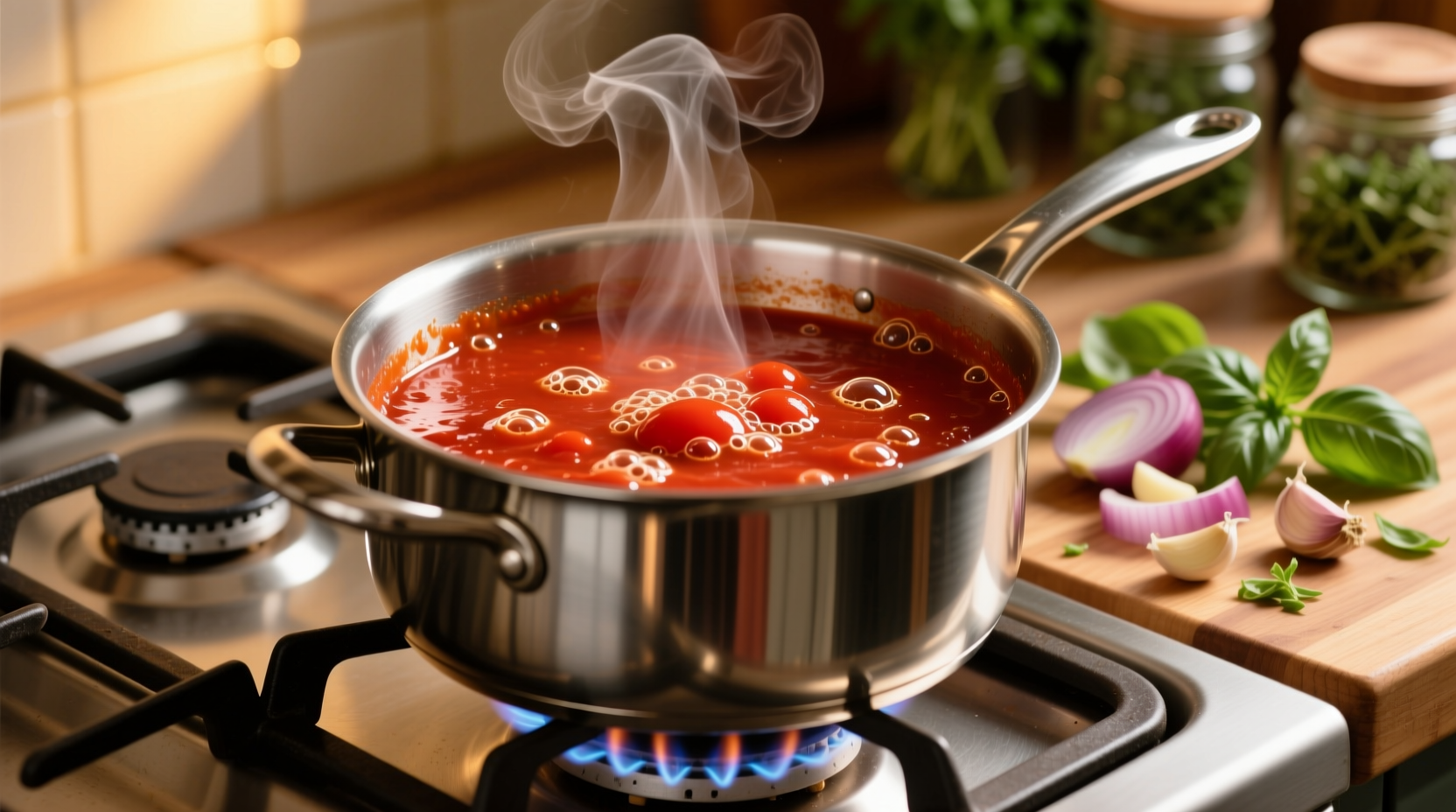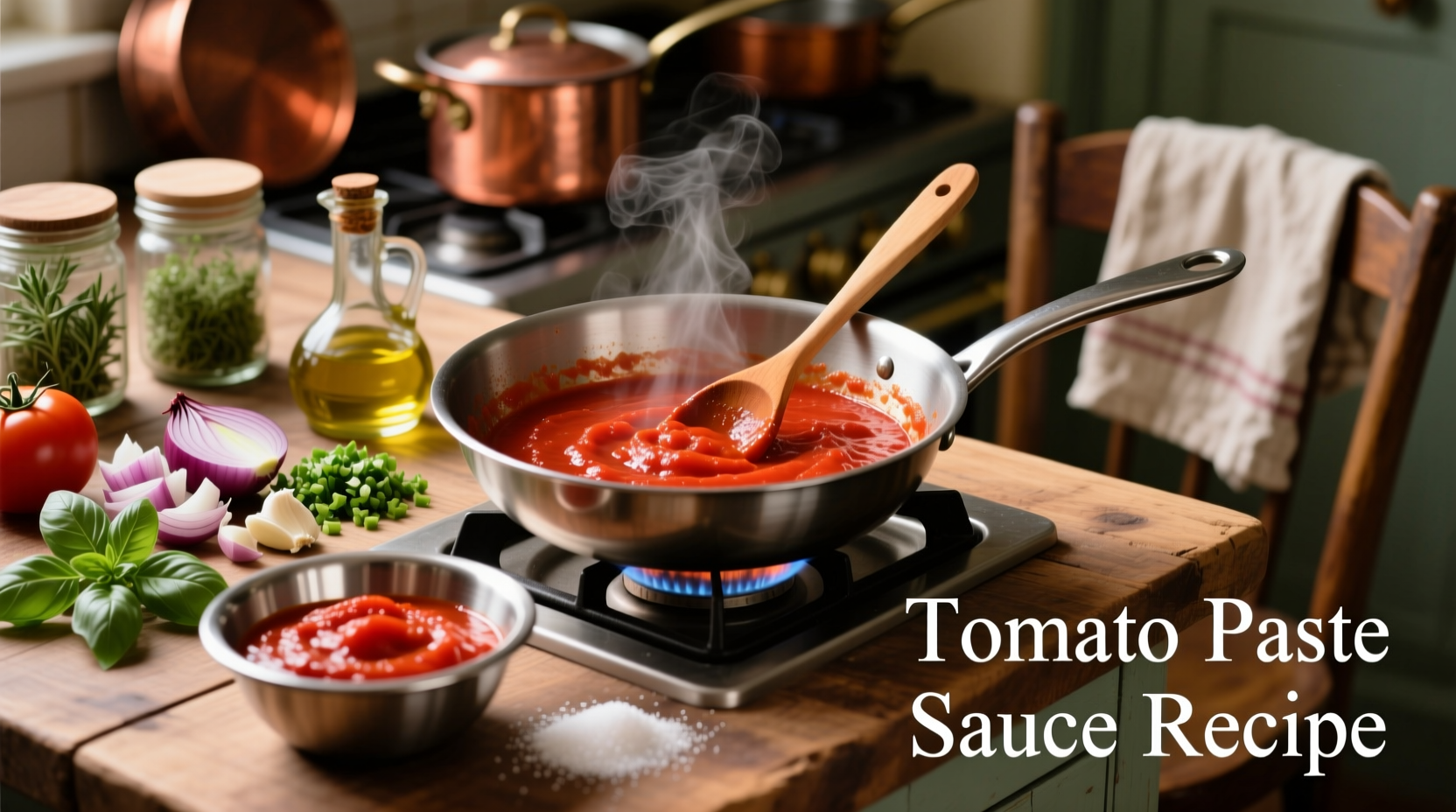Combine 1 part tomato paste with 2 parts water, add sautéed garlic and onions, season with basil, oregano, and a pinch of sugar, then simmer for 20-30 minutes. This creates a rich, flavorful tomato sauce ready for pasta, pizza, or casseroles using pantry staples you likely already have.
Running low on fresh tomatoes but craving homemade sauce? You're in luck. Transforming tomato paste into vibrant tomato sauce is one of the most practical kitchen skills for busy cooks. This method delivers consistent results year-round, uses ingredients you probably have in your pantry, and takes less than 30 minutes from start to finish. Unlike store-bought alternatives, you control every ingredient—no preservatives, no artificial flavors, and perfect seasoning tailored to your taste.
Why Tomato Paste Makes the Best Pantry Sauce
Tomato paste concentrates flavor by removing water content, giving you a flavor powerhouse that reconstitutes beautifully. Professional chefs keep tomato paste on hand precisely because it delivers consistent tomato flavor regardless of season. The USDA confirms that properly stored tomato paste maintains nutritional value for up to 24 months, making it a reliable pantry staple when fresh tomatoes aren't at their peak.
| Tomato Product | Water Content | Flavor Concentration | Best For |
|---|---|---|---|
| Tomato Paste | 24-30% | High (6x concentration) | Sauces, stews, flavor base |
| Canned Crushed Tomatoes | 94% | Medium | Chunky sauces, soups |
| Tomato Sauce (canned) | 95% | Low | Quick preparations |
Source: National Center for Home Food Preservation, University of Georgia
Gathering Your Ingredients
For one standard batch (enough for 4 servings of pasta):
- 1 (6 oz) can tomato paste (preferably double-concentrated)
- 1¾ cups water or vegetable broth
- 2 tbsp olive oil
- 3 garlic cloves, minced
- 1 small onion, finely diced
- 1 tsp dried basil
- 1 tsp dried oregano
- ½ tsp red pepper flakes (optional)
- 1 tsp sugar
- Salt to taste
Pro Tip: Choose tomato paste labeled “double-concentrated” for deeper flavor. The Food and Drug Administration requires this labeling when paste has undergone additional concentration beyond standard processing.
Your Step-by-Step Sauce Making Journey
Phase 1: Building Flavor Foundations (5-7 minutes)
Heat olive oil in a medium saucepan over medium heat. Add onions and sauté until translucent (about 3 minutes), then add garlic and cook until fragrant (about 30 seconds). This critical step develops flavor compounds that can't be replicated by simply adding raw garlic to liquid.
Phase 2: Creating the Sauce Base (3 minutes)
Add tomato paste to the pan and cook for 2-3 minutes while stirring constantly. This “toasting” technique caramelizes natural sugars and eliminates any metallic taste from the can. Gradually whisk in water or broth until smooth—adding liquid slowly prevents lumps.
| Time | Action | Visual Cue |
|---|---|---|
| 0-3 min | Saute onions and garlic | Onions become translucent |
| 3-5 min | Cook tomato paste | Paste darkens slightly |
| 5-25 min | Simmer sauce | Bubbles break slowly |
Phase 3: Simmering to Perfection (20-30 minutes)
Bring the mixture to a gentle simmer, then reduce heat to low. Add dried herbs, red pepper flakes, and sugar. Simmer uncovered for 20-30 minutes, stirring occasionally. The sauce is ready when it coats the back of a spoon. This reduction concentrates flavors and allows herbs to fully infuse.
Phase 4: Final Adjustments (2 minutes)
Taste and adjust seasoning. Need more depth? Add a splash of red wine. Too acidic? Another pinch of sugar. Too thick? A tablespoon of water. For fresh flavor, stir in 2 tbsp chopped basil just before serving.

Troubleshooting Common Sauce Issues
Sauce tastes metallic: You didn't cook the tomato paste long enough. Always sauté paste for 2-3 minutes before adding liquid.
Sauce is too thin: Continue simmering uncovered for additional 5-10 minutes. The sauce will thicken as water evaporates.
Sauce lacks depth: Add umami boosters like 1 tsp soy sauce or 2 reconstituted dried mushrooms.
Sauce is too acidic: Balance with 1–2 tsp sugar or a pinch of baking soda (1–2 dashes).
When to Use This Method (and When Not To)
This technique shines when:
- You need sauce quickly with pantry ingredients
- Fresh tomatoes aren't in season
- You want consistent flavor for meal prep
Avoid this method when:
- Perfectly ripe, in-season tomatoes are available (use fresh instead)
- Creating a raw tomato sauce like salsa fresca
- Specialty dishes requiring specific tomato varieties (like San Marzano-based Neapolitan pizza sauce)
Storage and Usage Tips
Cool sauce completely before storing in airtight containers. The USDA recommends refrigerating for up to 5 days or freezing for up to 6 months. When freezing, leave 1 inch of headspace for expansion. Thaw overnight in the refrigerator before reheating gently over low heat.
Delicious Variations to Try
Creamy Tomato Basil: Stir in 2 tbsp heavy cream and 1–2 tbsp fresh basil at the end.
Arrabbiata Style: Double the red pepper flakes and add 1 minced fresh chili.
Vodka Sauce: After simmering, add 2 tbsp vodka and 2 tbsp heavy cream, simmer 5 more minutes.
Garden Vegetable: Add 1 diced carrot and 1 diced celery stalk with the onions.
Frequently Asked Questions
What's the correct tomato paste to water ratio for sauce?
The ideal ratio is 1 part tomato paste to 2–2.5 parts water. For a 6 oz can of paste, use 1¾ cups liquid. Adjust based on desired thickness—add more liquid for thinner sauces like pizza base, less for thicker pasta sauces.
Can I use tomato sauce instead of tomato paste?
Tomato sauce has higher water content (about 95% vs paste's 24-30%), so you'd need to reduce it significantly. For best results, stick with paste which provides concentrated flavor. If substituting, use 2 cups tomato sauce reduced by half before adding other ingredients.
Why add sugar to tomato sauce?
Sugar balances natural acidity in tomatoes. The amount needed depends on tomato variety and ripeness—start with 1 tsp per 6 oz paste and adjust to taste. Many commercial sauces use calcium chloride instead, which our homemade version avoids.
How do I make the sauce richer without meat?
For vegetarian depth, add 1 tsp soy sauce or 2 reconstituted dried mushrooms during simmering. Roasted red peppers (1–2 tbsp) or a Parmesan rind (remove before serving) also boost umami without meat products.
Can I can this homemade sauce for long-term storage?
Yes, but follow USDA canning guidelines precisely. Process pints for 35 minutes in a boiling water bath. Always add 1 tbsp lemon juice per pint to ensure proper acidity (pH below 4.6) for safe canning. Never can reduced-sodium versions as salt affects preservation.











 浙公网安备
33010002000092号
浙公网安备
33010002000092号 浙B2-20120091-4
浙B2-20120091-4